#dance competitions
Text
That feeling when you start really researching the most random topic in great detail just cause you wanna write an AU
#joker out#i wont say what im writing#but like ill kinda say what im writing#west coast swing#dancing#dance competitions#bokris#bojan cvjetićanin#kris guštin#they both got dancers arses dont lie#especially bojan#he has like the whole physique
17 notes
·
View notes
Text
Sick to my stomach thinking how fucking normalized it was growing up as a competitive dancer to go to dance competitions and see middle-aged men stare at little girls in bikini sequin outfits all day. It's fucking weird, I don't care if they were on the "judges panel" hahaha what the actual fuck
4 notes
·
View notes
Text
SURPRISING Reasons Why Some Dance Adjudicators Reward Trick-Laden Routines
I bet you dance teachers and parents can relate: some dance competition adjudicators reward routines with the most tricks crammed apiece. Social media is rife with comments about them.
One teacher pleaded, “I also feel that one of the many ways to change this is up to us instructions, directors, and choreographers, specially in the competition circuit: we need to stop to glamorize tricks over substance.”
“We need to stop rewarding dangerously achieved contortionist-like positions and tumbling-style choreo that have no meaning. These don't belong in a dance choreography especially when they don't help to tell a story or have a connecting step. What happened to artistry, musicality, hard work, technique? When did it become ok to leave this out?”
“If we stop choreographing that in, and present a piece where dancers DANCE, we will be able to change this from within. I am not alone on this and if we all unite we can make the change! It may be hard at the beginning because some of those professionals who judge will go for the awe provoking trick, but we need to be consistent and change will happen.”

As a dance history buff, I turned to Poe – Quora’s free app in which you can ask their AI bots questions – on why some dance adjudicators do those things. Here are key points:
1. Entertainment Value: Tricks can be visually impressive and captivating for the audience. Judges may reward routines with many tricks because they believe it enhances the overall entertainment value of the performance. These moves can generate excitement, thrill, and leave a lasting impression on the viewers.
2. Trend Influence: Dance competitions, like any other field, can be influenced by trends. If there is a current trend or popular style that emphasizes tricks or acrobatic elements, judges may be more inclined to reward routines that align with these trends to reflect the preferences of the dance community at that time.
I have to say that those reasons are most valid takeaways when it comes to a number of, as opposed to all, dance adjudicators who reward the most trick-intensive routines.

But a chapter in the book Rooted Jazz Dance: Africanist Aesthetics and Equity in the Twenty-First Century further provided me with more insight on this. It made me realize that the ones who reward the most trick-intensive routines byproducts of choreographic anti-intellectualism. This is when the dance industry places greater emphasis on fame and trend influences over history, safe technique, and heritage, especially in jazz dance.
Utah high school jazz teacher Jessie McCullough noticed initial resistance from her incumbent students when she started teaching the genre, and her classes were different and had more movements rooted in African American heritage.
In her classes, dancers would wear school dress code-compliant dancewear as opposed to bra tops and booty shorts over bare legs. Turkey trots, Savoy kicks, eagle slides, and Jump Charlestons would trump over calypso leaps, a la seconde turns, turning disc jumps, and firebird leaps. The students wouldn’t compete at commercial competitions, but instead they’d dance in their annual showcases.
They key root of McCullough’s students’ resistances is ego orientation, a strong comparison with others and a desire to win.
“Students with ego orientation can have lower self-esteem, suffer from performance anxiety, and have a tremendous fear of making mistakes and an addiction to perfectionism,” she explained on Chapter 18 of Rooted Jazz Dance.
“These fears can greatly impact a student’s ability to engage with new material. As they have a learned desire to equate quality dancing with Eurocentric models of perfectionism, exploring jazz from a new perspective can be disconcerting.”

And it doesn’t help that the staple competitive dance jazz movements stem from Caucasian-majority aesthetic sports AS WELL AS ballet. For instance, the pirouette detire – known as the “leg hold turn” – has its roots in figure skating and rhythmic gymnastics, the latter of which the International Gymnastics Federation calls it in their Code of Points “a split pivot with help.”
McCullough’s students were afflicted with the “illusion of knowing,” the belief that they had learned something when they actually hadn’t. “Competition students can cling to learned beliefs about jazz out of a desire for correctness,” she further explained.
“Competition rewards virtuosic movements, often referred to as ‘tricks,’ and teaches students that sharp, aggressive, sassy, and/or sexy movements are jazz. Add to this a fierce loyalty to competition teams and coaches – and a top prize-winning jazz routine – and students may falsely believe that competition versions of jazz are ‘true jazz’ and the instructor new, sometimes contradictory ideas is ill-informed.”
To further confirm reasons why some dance judges reward the most trick-intensive routines, those two traits – further exacerbated by trend influences on social media and reality television (e. g., SYTYCD and Dance Moms) – combine to create cognitive dissonance.
“I see very little choreography in competition dance that would be ‘at home’ on the Broadway stage or in a concert dance company,” Luigi Technique teacher Bill Waldinger explained on the cognitive dissonance, “And similarly, a piece like Bob Fosse’s ‘Rich Man’s Frug,’ brilliant as it is, would not do well at a competition due to its lack of technical difficulty despite its incredibly challenging artistic demands.”
All the key factors lead to confirmation bias, a tendency to seek information that concerns rather than discredits current beliefs.
McCullough recalled, “When exploring vernacular jazz, students in my class sometimes struggle to make their own choices regarding movement possibilities in improvisation and movement creation activities. They often fill their improvisations and choreographies with the virtuosic movements, valued at competition, striving for a previously learned version of ‘correctness.’”
She concluded on the high-scoring, highly-trick-intensive routines, “(They) are highly commercialized and often utilize Eurocentric technique. These portrayals inform student expectations of jazz and influence what studios teach, reinforcing a belief that commercialized representations of jazz are most valuable and uphold students’ illusion of knowing.”
As Bob Boross, a pupil of Jack Cole protégé Matt Mattox, lamented in 1996, “Our dancers are going through their dance careers with blinders on, ignorant of the rich heritage of social and theatrical dance styles that make up the whole of the jazz dance experience.”
“They also are growing up without exposure to real jazz music - music that swings. Our dancers are performing a hybrid theatrical movement to pop music, but probably wouldn't know a Lindy from a Shorty George. Finally, they are being given the impression that jazz dance is only commercial - to entertain or impress.”
Some of those same dancers eventually grew up to be THOSE dance judges who’d score the most trick-laden routines highly. Most of them, in fact, lacked sufficient exposure to vernacular jazz dance as well as all genres of jazz music.
“It’s important to note that while tricks can be impressive and exciting, they are not the sole criteria for judging a dance routine,” the Poe answer read, “Other elements such as musicality, technique, choreography, interpretation, and overall performance quality should also be taken into consideration to ensure a fair and balanced evaluation of the dancers' abilities.”
Especially regarding musicality and performance quality, the best way to shift judges perceptions on tricks being more prize worthy is using trend influences to teach jazz dance history.
It’s highly understandable that the latter group of people have very tight schedules and are often too hard-pressed to read books on it, hence why some would reward the more trick-intensive routines in the first place. But they mostly have extra free time to watch old footage of vernacular jazz or videos of previous Lindy Hop competitions on YT.
youtube
We should encourage dancers, their supporting kin, dance teachers, and judges to follow accounts that show insights on it such as Sue Samuels’ Jazz Roots, Pat Taylor’s JazzAntiqua, and Afro Lindy Hopper.
Sharing video footage and photos of celebrated POC figures in the genre such as Pepsi Bethel, Eithel Smith, and Ed Mock (whose named company’s member was the late lyrical dance choreographer Doug Caldwell) on social media is a convenient way to help dance judges – and teachers and students – understand and learn from jazz dance history.
Students – and teachers themselves – may also tape themselves (with proper technique and background knowledge teaching) dancing those rooted moves, Charlestons included. Who knows – will the Black Bottom become the NEW a la seconde turns? Will the Jump Charleston match the popularity of the firebird jump?
youtube
#zazzlemade#jazz dance history#vernacular jazz dance#dance competitions#competition dance#dance history#black history month
0 notes
Text

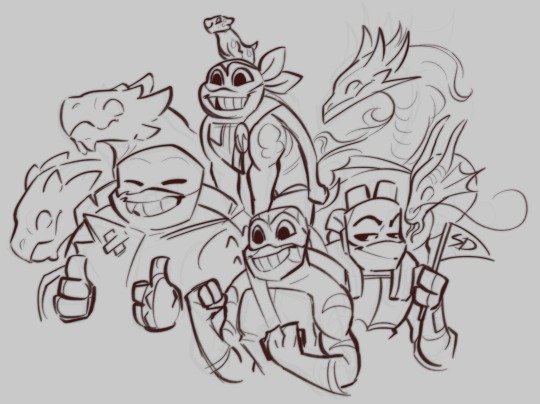
One of my moots! @bluesgras !!
Good luck in the au competition, the spitfire bros are cheering you on・:*+.
#gotta show love to ma moots that are competing#happy little dance as I draw different AU’s#tmnt snapdragon#tmnt au competition#tmnt spitfire#tmnt spitfire au#rottmnt spitfire au#rottmnt spitfire#tmnt crossover#my art#tmnt#rottmnt#tmnt au propaganda#<—- I guess sorta?#art 4 others
986 notes
·
View notes
Text



555 notes
·
View notes
Text

an excuse to draw swanatello as a flapper? :3c well gosh if you insist.
@tmntaucompetition
#now that main brackets are out (kinda) i can start slowly releasing my 1920s propaganda :3c#see? hes not having a TOTALLY bad time#he gets to dance still <3#tmnt au competition#propaganda#rottmnt#rise of the tmnt#rise of the teenage mutant ninja turtles#rottmnt donnie#rottmnt donatello#fidgetwing
835 notes
·
View notes
Text
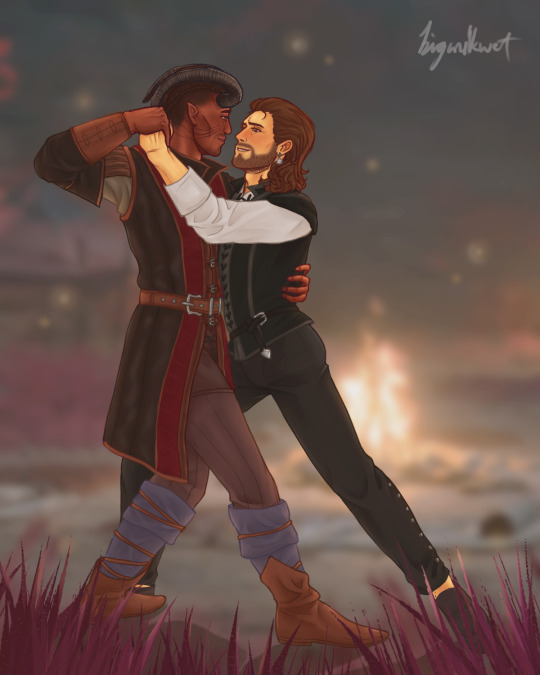
hi tumblr, do you think they've explored eachother's bodies?
gale and wyll being widely slept on rn 😭
#literally haven't done any digital art in years and thIS is what i draw 😭#all bc of that one gifset of gale saying i can dance too :) and wyll going i'd love to have seen it you're prolly elegant#and now i cant stop thinking about the mindbendingly nearly competitive romantic acts they'd try to one up eachother with#gale x wyll#wyll x gale#bladeweave#gale dekarios#wyll ravengard#bg3#bg3 fanart
521 notes
·
View notes
Text
Can someone out there write a Jegulus competitive ballroom dance AU? I've been watching those videos where there are 2 people at an improve competition and they've never met before let alone danced together and then they end up having immaculate chemistry and decide to be each other's dance partners.
I would write it myself, but i know absolutely nothing about dancing. Competitive or otherwise. But I would kill to read this.
In the meantime, I guess I'll just have to reread 'You Signed Up For This' by Sollmussa because honestly, the dancing in that one wrecked me beyond repair.
.
.
Okay, I thought was done, but I'm so not. Here are some things about the AU that I desperately crave:
Latino James. Dance is actually his 3rd language and he's fluent.
Effie and Monty met each other in a dance class when they were teens, and then they were paired up with each other by the teacher. They had a bit of a rivalry at first, but then as they started dancing together more and more, they fell in love. The two ended up becoming very famous competitive ballroom dancers and retired when they had James. They never stopped dancing though and they engrained that love into James
Former Ballet dancer Regulus. He stopped dancing ballet after he finally left his family home to live with Sirius. He still loves dancing, but ballet has too many bad memories attached to it and he lost his love for it.
Sirius introduced him to this type of competitive dance via Effie's class. He still doesn't meet James until he's actually at a competition though. ^.^
Bonus:
Pandora and Evan did ballet with Regulus and Sirius when they were kids but left to do other types of dance before they were even teenagers.
Evan and Panda used to dance competitively together until Regulus needed a partner for his first competition and Pandora volunteered. Evan was cool with it, because it's Regulus, but there's a tiny part of him that's just like, 'Well who am I going to dance with then?'
Enter Barty, someone who is known among other dancers for being notorious for scaring away his dance partners.
Holy shit guys I take it all back. I need to write this. Forget the fact that I don't know anything, ja boi is gonna have to fucking learn.
Stay tuned because I might have some brainrot about this one as things progress~
#competitive ballroom dancing AU#jegulus#aka Quinn has read a couple ballroom dance manga and watched some people dance online and is now an expert#the marauders#wolfstar#marauders era#regulus black#james potter#sirius black#starchaser#remus lupin#rosekiller#self indulgent#euphemia potter#effie potter#fleamont potter#latino james potter
222 notes
·
View notes
Text
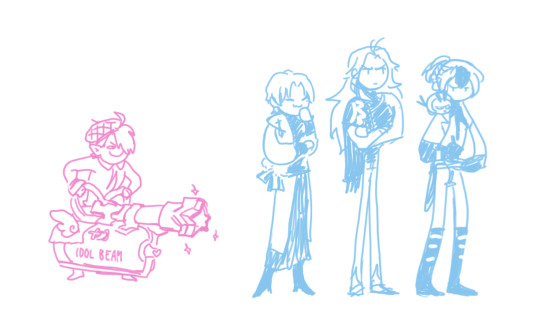
(3) remaining
#OH NO THE IDOL BEAM HAS HIT EVERYONE EXCEPT THE MEANEST ONES IN THE CLAN 🤣#can u imagine.... the absolute catty group energy coming out of these 3 if they had to sing together...#the idol beam bazooka is one of aster's fave weapons of ???profit#rei and kuya hate standing beside each other so dante always has to be in the middle#everyone who attends any of their shows will get their memory instantly wiped after the event#whether it's by illusory magic or fiery explosion (fire comas don't completely erase the memory but they'll certainly distract)#or father directly clawing someone's eyes out#actually i wouldn't put it past kuya to just make an entire illusion out of the thing#so he wouldn't have to move at all or put any effort into the silly song and dance.#he sittin backstage with the catering table while the audience screams for the fake show happening on stage#kuya the pioneer of IRL MMV projection magic. incredible#actually u kno what. aster hits them with the idol beam#and every show is just the three of them playing UNO#that would still bring in money#the drama. the intrigue. the competitive spirits flaring and tables being flipped. what a spectacle#aster#kuya#dante#rei#nu carnival
362 notes
·
View notes
Text
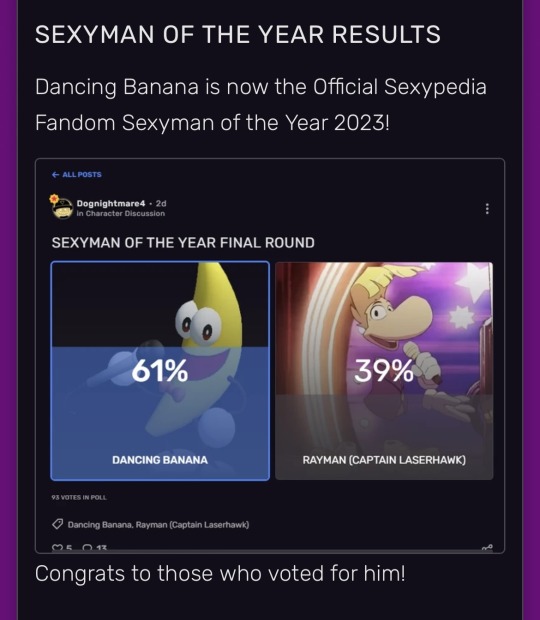

He did it...
#dancing banana#shovelware's brain game#shovelware’s brain game#shovelware studios#peanut butter jelly time#ya'll have no ideas how many polls he's lost on here so to see him finally win a big one is insane#rayman#sorry to the rayman fans though. Still 2nd place isn't bad considering the othet sexymen in the competition#ramon captain laserhawk#rayman captain laserhawk
344 notes
·
View notes
Note
How do you feel about winning the competition

#i had another ask about someone saying congrats for winning the competition but tumblr deleted it :[ STILL. THANK YOU!!!#i do a little dance i do a little jig#im kind of surprised the au got first place hehhdevgfreh#im very happy!! :']#i have gabriel brainrot atm but dont yall think ive forgotten about peepaw au#they mean so much to me#ask#peepaw and babies au
459 notes
·
View notes
Text

today's fashion doll is: Barbie in The 12 Dancing Princesses (2006)
#i have a dance competition today so she felt appropriate lol#dollblogging#dollblr#fashion doll#fashion doll of the day#fashion dolls#doll#barbie#2006#barbie in the 12 dancing princesses
264 notes
·
View notes
Text




~you construct rituals of competition with another man as an outlet for feelings you do not want to name or fully understand~
#inchreplies#landoscar#grateful thanks to this kind of complex real sht happening to the lando ship where fandom fully accepts the gf already#bc the dance they do between almost crazily intimate baby voices and sweetness and mild obsession w each other#to trying to redirect their energies on healthy competition that just ends up w them looking intensely at each other for no reason#is just a lot to try and understand let alone worry ppl will run w it and go insane#btw I'm erasing twitter urls where idk the acc and not sure if I should be sharing orposting here#mutual obsession#mine#lando's oscar obsession
107 notes
·
View notes
Text
Oh wan! Isn’t can—TO YOU! You can pry atsushi’s little as if, bruh and akutagawa asking is Dazai a bidet guy? and Dazai and chuuya saying he is pretty badass out of my cold dead hands
#IT IS CANON TO ME!!!#THE DANCE COMPETITION#god I love it#the ep where they switch bodies?#distracts me from the angst fest that is the current manga#bsd#bungou stray dogs#bungo stray dogs#bsd atsushi#bsd akutagawa#bsd wan#bsd manga#bsd chuuya#bsd dazai#sskk#skk
545 notes
·
View notes
Text
Me before starting this GOT fic: oh man I just have all these thoughts and feelings about how the political system of Westeros (and Essos too but at least that's got the terrible excuse of "city states but racist" lazy worldbuilding; you'd think Martin would at least care about the central premise of his series) is so internally incoherent, we're going to have to dig into all of that
Me while writing this GOT fic: yeah for sure for sure but also I really need to explain the extremely different dance traditions for each kingdom and why Riverlands dances are analogous to huge group Tinikling competitions between men and women and how that directly translates to the Iron Island's "dancing is how we scare our enemies" approach to dance (also the extremely rigid bifurcation not between "men's dancing" and "women's dancing" but between "sailor's dancing while onboard," "sailor's dancing while at port/on land," and "dancing of the people who make the sailing possible aka a lot of the women yes but at least in an INTERESTING way"). And then of course how the Riverlands' dancing directly ties into the Westerlands' dancing which is mixed-gender and involves a lot of swinging your partner around and lifting them up (hence one reason strong women in the Westerlands are valued since you BOTH gotta pick each other up) and hey let's talk about some of the really intriguing similarities between the dance traditions of the mountain clans in both the North and the Vale and hey wait guys where are you going guys GUYS
#it goes without saying that sansa is great at all of them#there's a dance at Riverrun which of course isn't a competition at all but actually it is#and Sansa is there to WIN IT#still on the fence about giving Sansa a love interest but everybody's going to be like 'damn girl's got gams'#'and the bloodthirsty desire to conquer all who would oppose her through the power of dance'#game of thrones motherfuckers#got: bitches get stuff done#game of thrones
108 notes
·
View notes
Text
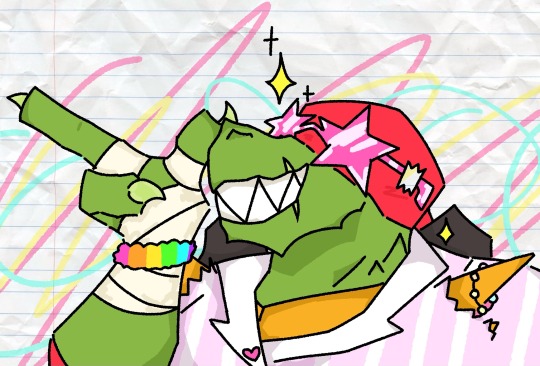

March for Raph day 16!:
Dance competition
Mikey just let him be an icon for a moment ✨
I made a drawing of a more turtle-e Raph and I was like “I need to post this” so.. here it is!
I just love it when people draw the turtle more ‘realistic’ and stuff they look so cool
Leo is Raphs number one hypeman (when they aren’t fighting lol)
#march for raph#dance competition#rise raph#he’s so silly goofy y’all#save rise of the tmnt#raph is so underrated smh#bring back rottmnt#art#digital art#save rottmnt#drawing#i love rottmnt#slay#rise of the teenage mutant ninja turtles#rottmnt#rottmnt fanart#what icons#a team#raph my son#rottmnt raph#rottmnt art#rise of the tmnt#unpause rottmnt#Nickelodeon I’m begging#with the original cast tho#I will combust if you don’t#rise leo#rise mikey#rottmnt leo#rottmnt mikey
73 notes
·
View notes